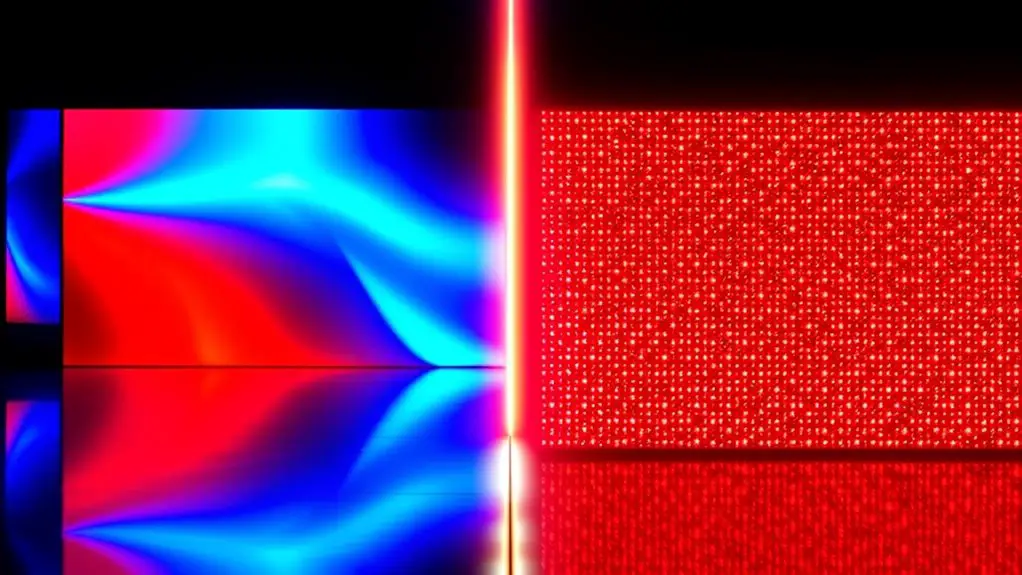When comparing Nano-LED and MicroLED technologies, you'll find that each has its unique advantages. Nano-LEDs shine in color reproduction, providing vibrant visuals and deep blacks, perfect for immersive viewing. In contrast, MicroLEDs excel in brightness and longevity, making them ideal for bright environments. Both consume less power, but their performance varies based on viewing preferences and applications. If you're curious about how these technologies are manufactured and where they truly excel, there's more to explore.
Understanding Nano-LED Technology
As you plunge into the world of Nano-LED technology, you'll discover that it represents a significant leap in display innovation. This cutting-edge technology utilizes microscopic light-emitting diodes to create vibrant, high-resolution displays. One of the primary nano LED advantages is its ability to deliver superior brightness and color accuracy, making it ideal for applications in televisions, smartphones, and virtual reality headsets. Unlike traditional LED displays, nano LEDs consume less power, which is a major plus for energy-conscious consumers. Furthermore, the compact size of these diodes enables more flexible design options, paving the way for thinner and lighter devices. By understanding nano LED applications and advantages, you can appreciate how this technology is reshaping the visual experience, offering unprecedented freedom in display design.
Exploring MicroLED Technology
While both Nano-LED and MicroLED technologies aim to revolutionize display quality, MicroLED stands out with its unique approach to screen innovation. As you explore MicroLED, you'll discover several key advantages and limitations:
MicroLED technology offers a unique and innovative approach to enhancing display quality and design flexibility.
- Brightness: MicroLED displays can achieve incredible brightness levels without compromising quality.
- Longevity: With no burn-in issues, MicroLED offers a longer lifespan than traditional OLED screens.
- Energy Efficiency: MicroLED technology consumes less power, making it eco-friendly.
- Scalability: You can create various display sizes and shapes, offering unparalleled design freedom.
However, MicroLED also has limitations, such as high production costs and complexity in manufacturing. Balancing these advantages and limitations can help you make informed decisions about this cutting-edge technology.
Performance Comparison: Brightness and Color Accuracy
MicroLED technology's impressive attributes in brightness and longevity set the stage for a performance comparison with Nano-LED displays. When you consider brightness levels, MicroLEDs often outperform Nano-LEDs, delivering higher peak brightness, which enhances visibility in bright environments. This can make a significant difference when you're watching content outdoors or in well-lit rooms.
On the other hand, Nano-LEDs excel in color reproduction, providing deeper blacks and more vibrant hues due to their smaller pixel size. This can lead to a more immersive viewing experience, particularly for cinematic content. Ultimately, while MicroLEDs shine in brightness, Nano-LEDs offer a richer color palette. Depending on your viewing preferences, either technology can elevate your visual experience.
Manufacturing Processes: Challenges and Innovations
When evaluating the manufacturing processes behind Nano-LED and MicroLED technologies, several challenges and innovations emerge that impact production efficiency and display quality. Here are some key manufacturing challenges and their innovative solutions:
- Material Limitations: Both technologies face constraints in available materials, but breakthroughs in nanomaterials are paving the way for better options.
- Yield Rates: Low yield rates can hinder profitability, leading to innovations in automated inspection and repair processes.
- Scale-Up Issues: Shifting from prototypes to mass production is tricky; innovative techniques like printing and advanced lithography are helping.
- Cost Management: High production costs pose a barrier, but innovative solutions like shared manufacturing facilities can alleviate financial strain.
Navigating these hurdles is vital for the future of both Nano-LED and MicroLED technologies.
Application Suitability: Where Each Technology Excels
As you explore the application suitability of Nano-LED and MicroLED technologies, it becomes clear that each has distinct advantages tailored to different use cases. Nano-LEDs shine in compact devices, like wearables and smartphones, where space is tight and power efficiency is essential. Their ability to deliver vibrant colors in small displays aligns perfectly with current market trends toward miniaturization. On the other hand, MicroLEDs excel in larger display scenarios, like TVs and digital signage, offering superior brightness and contrast. As you consider application scenarios, think about how these technologies can enhance user experiences—Nano-LEDs for portability and MicroLEDs for expansive visuals. Ultimately, your choice will depend on specific needs and the evolving landscape of display technology.
Frequently Asked Questions
What Are the Main Differences in Energy Consumption Between Nano-Led and Microled?
When evaluating energy consumption, you'll find nano-LEDs generally offer greater energy efficiency and lower power usage compared to MicroLEDs. This means they can operate with less energy, contributing to a more sustainable technology choice for your needs.
How Do Nano-Led and Microled Technologies Impact Device Longevity?
When considering device longevity, you'll find that both nano-LED and microLED technologies enhance display lifespan and device durability. Their efficient performance and lower heat generation contribute to longer-lasting devices, ideal for your freedom-driven lifestyle.
Are There Any Health Concerns Associated With Nano-Led or Microled Displays?
You might wonder about health risks linked to nano-LED or microLED displays. While studies suggest minimal visual effects, prolonged exposure could lead to eye strain. It's crucial to monitor usage for overall well-being and comfort.
What Is the Cost Difference Between Nano-Led and Microled Technology?
Think of production costs like a rollercoaster ride—market trends can dip and soar. Nano-LEDs often come cheaper initially, but as technology matures, MicroLEDs might offer better long-term value despite higher upfront costs.
How Do Environmental Factors Affect Nano-Led and Microled Performance?
Environmental factors like temperature sensitivity and humidity effects greatly impact performance. If you're using these technologies in varying conditions, understanding their responses to heat and moisture can enhance your display experience and longevity greatly.

